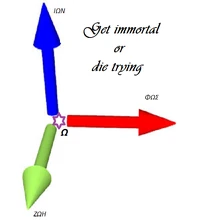Καμπυλόγραμμον Σύστημα Συντεταγμένων
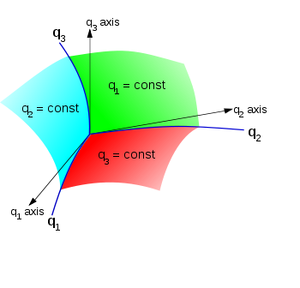

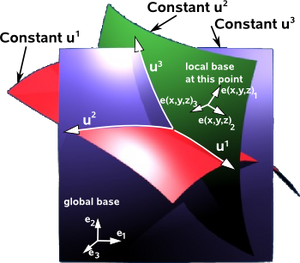
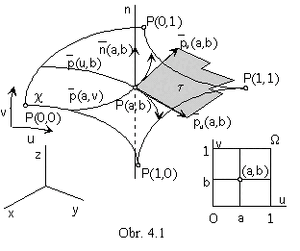
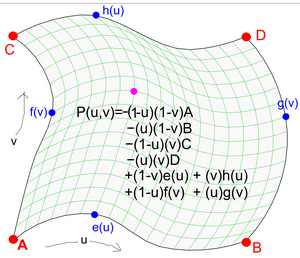
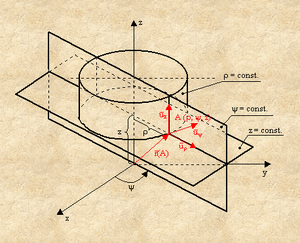
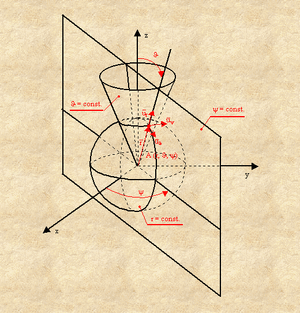

Είναι ένα Σύστημα Συντεταγμένων.
Ετυμολογία[]
Η ονομασία "Καμπυλόγραμμη" σχετίζεται ετυμολογικά με την λέξη "καμπύλη".
Εισαγωγή[]
In geometry, curvilinear coordinates are a coordinate system for Euclidean space in which the coordinate lines may be curved. These coordinates may be derived from a set of Cartesian coordinates by using a transformation that is locally invertible (a one-to-one map) at each point. This means that one can convert a point given in a Cartesian coordinate system to its curvilinear coordinates and back. The name curvilinear coordinates, coined by the French mathematician Lamé, derives from the fact that the coordinate surfaces of the curvilinear systems are curved.
Well-known examples of curvilinear coordinate systems in three-dimensional Euclidean space (R3) are Cartesian, cylindrical and spherical polar coordinates. A Cartesian coordinate surface in this space is a plane; for example z = 0 defines the x-y plane. In the same space, the coordinate surface r = 1 in spherical polar coordinates is the surface of a unit sphere, which is curved. The formalism of curvilinear coordinates provides a unified and general description of the standard coordinate systems.
Curvilinear coordinates are often used to define the location or distribution of physical quantities which may be, for example, scalars, vectors, or tensors. Mathematical expressions involving these quantities in vector calculus and tensor analysis (such as the gradient, divergence, curl, and Laplacian) can be transformed from one coordinate system to another, according to transformation rules for scalars, vectors, and tensors. Such expressions then become valid for any curvilinear coordinate system.
Depending on the application, a curvilinear coordinate system may be simpler to use than the Cartesian coordinate system. For instance, a physical problem with spherical symmetry defined in R3 (for example, motion of particles under the influence of central forces) is usually easier to solve in spherical polar coordinates than in Cartesian coordinates. Equations with boundary conditions that follow coordinate surfaces for a particular curvilinear coordinate system may be easier to solve in that system. One would for instance describe the motion of a particle in a rectangular box in Cartesian coordinates, whereas one would prefer spherical coordinates for a particle in a sphere. Spherical coordinates are one of the most used curvilinear coordinate systems in such fields as Earth sciences, cartography, and physics (in particular quantum mechanics, relativity), and engineering.
Orthogonal curvilinear coordinates in 3d[]
Coordinates, basis, and vectors[]
Fig. 1 - Coordinate surfaces, coordinate lines, and coordinate axes of general curvilinear coordinates.
Fig. 2 - Coordinate surfaces, coordinate lines, and coordinate axes of spherical coordinates. Surfaces: r - spheres, θ - cones, φ - half-planes; Lines: r - straight beams, θ - vertical semicircles, φ - horizontal circles; Axes: r - straight beams, θ - tangents to vertical semicircles, φ - tangents to horizontal circles
For now, consider 3d space. A point P in 3d space can be defined using Cartesian coordinates (x, y, z) [equivalently written (x1, x2, x3)], or in another system (q1, q2, q3), as shown in Fig. 1. The latter is a curvilinear coordinate system, and (q1, q2, q3) are the curvilinear coordinates of the point P.
The surfaces q1 = constant, q2 = constant, q3 = constant are called the coordinate surfaces; and the space curves formed by their intersection in pairs are called the coordinate curves. The coordinate axes are determined by the tangents to the coordinate curves at the intersection of three surfaces. They are not in general fixed directions in space, which happens to be the case for simple Cartesian coordinates.
A basis whose vectors change their direction and/or magnitude from point to point is called local basis. All bases associated with curvilinear coordinates are necessarily local. Basis vectors that are the same at all points are global bases, and can be associated only with linear or affine coordinate systems.
Note: usually all basis vectors are denoted by e, for this article e is for the standard basis (Cartesian) and b is for the curvilinear basis.
The relation between the coordinates is given by the invertible transformations:
Any point can be written as a position vector r in Cartesian coordinates:
where x, y, z are the coordinates of the position vector with respect to the standard basis vectors ex, ey, ez.
However, in a general curvilinear system, there may well not be any natural global basis vectors. Instead, we note that in the Cartesian system, we have the property that
We can apply the same idea to the curvilinear system to determine a system of basis vectors at P. We define
These may not have unit length, and may also not be orthogonal. In the case that they are orthogonal at all points where the derivatives are well-defined, we define the Lamé coefficients (after Gabriel Lamé) by
and the curvilinear orthonormal basis vectors by
It is important to note that these basis vectors may well depend upon the position of P; it is therefore necessary that they are not assumed to be constant over a region. (They technically form a basis for the tangent bundle of at P, and so are local to P.)
In general, curvilinear coordinates allow the generality of basis vectors not all mutually perpendicular to each other, and not required to be of unit length: they can be of arbitrary magnitude and direction. The use of an orthogonal basis makes vector manipulations simpler than for non-orthogonal. However, some areas of physics and engineering, particularly fluid mechanics and continuum mechanics, require non-orthogonal bases to describe deformations and fluid transport to account for complicated directional dependences of physical quantities. A discussion of the general case appears later on this page.
Vector calculus[]
Πρότυπο:See also
Differential elements[]
Since the total differential change in r is
so scale factors are
They can also be written for each component of r:
- .
However, this designation is very rarely used, largely replaced with the components of the metric tensor gik (see below).
Covariant and contravariant bases[]
Πρότυπο:Main
A vector v (red) represented by • a vector basis (yellow, left: e1, e2, e3), tangent vectors to coordinate curves (black) and • a covector basis or cobasis (blue, right: e1, e2, e3), normal vectors to coordinate surfaces (grey) in general (not necessarily orthogonal) curvilinear coordinates (q1, q2, q3). Note the basis and cobasis do not coincide unless the coordinate system is orthogonal.[1]
The basis vectors, gradients, and scale factors are all interrelated within a coordinate system by two methods:
Πρότυπο:Ordered list
So depending on the method by which they are built, for a general curvilinear coordinate system there are two sets of basis vectors for every point: {b1, b2, b3} is the covariant basis, and {b1, b2, b3} is the contravariant basis.
A vector v can be given in terms either basis, i.e.,
The basis vectors relate to the components by[2]Πρότυπο:Rp
and
where g is the metric tensor (see below).
A vector is covariant or contravariant if, respectively, its components are covariant (lowered indices, written vk) or contravariant (raised indices, written vk). From the above vector sums, it can be seen that contravariant vectors are represented with covariant basis vectors, and covariant vectors are represented with contravariant basis vectors.
A key convention in the representation of vectors and tensors in terms of indexed components and basis vectors is invariance in the sense that vector components which transform in a covariant manner (or contravariant manner) are paired with basis vectors that transform in a contravariant manner (or covariant manner).
Covariant basis[]
Πρότυπο:Main
Constructing a covariant basis in one dimension[]
Fig. 3 – Transformation of local covariant basis in the case of general curvilinear coordinates
Consider the one-dimensional curve shown in Fig. 3. At point P, taken as an origin, x is one of the Cartesian coordinates, and q1 is one of the curvilinear coordinates (Fig. 3). The local (non-unit) basis vector is b1 (notated h1 above, with b reserved for unit vectors) and it is built on the q1 axis which is a tangent to that coordinate line at the point P. The axis q1 and thus the vector b1 form an angle α with the Cartesian x axis and the Cartesian basis vector e1.
It can be seen from triangle PAB that
where |e1|, |b1| are the magnitudes of the two basis vectors, i.e., the scalar intercepts PB and PA. Note that PA is also the projection of b1 on the x axis.
However, this method for basis vector transformations using directional cosines is inapplicable to curvilinear coordinates for the following reasons:
- By increasing the distance from P, the angle between the curved line q1 and Cartesian axis x increasingly deviates from α.
- At the distance PB the true angle is that which the tangent at point C forms with the x axis and the latter angle is clearly different from α.
The angles that the q1 line and that axis form with the x axis become closer in value the closer one moves towards point P and become exactly equal at P.
Let point E be located very close to P, so close that the distance PE is infinitesimally small. Then PE measured on the q1 axis almost coincides with PE measured on the q1 line. At the same time, the ratio PD/PE (PD being the projection of PE on the x axis) becomes almost exactly equal to cos α.
Let the infinitesimally small intercepts PD and PE be labelled, respectively, as dx and dq1. Then
- .
Thus, the directional cosines can be substituted in transformations with the more exact ratios between infinitesimally small coordinate intercepts. It follows that the component (projection) of b1 on the x axis is
- .
If qi = qi(x1, x2, x3) and xi = xi(q1, q2, q3) are smooth (continuously differentiable) functions the transformation ratios can be written as and . That is, those ratios are partial derivatives of coordinates belonging to one system with respect to coordinates belonging to the other system.
Constructing a covariant basis in three dimensions[]
Doing the same for the coordinates in the other 2 dimensions, b1 can be expressed as:
Similar equations hold for b2 and b3 so that the standard basis {e1, e2, e3} is transformed to a local (ordered and normalised) basis {b1, b2, b3} by the following system of equations:
By analogous reasoning, one can obtain the inverse transformation from local basis to standard basis:
Jacobian of the transformation[]
The above systems of linear equations can be written in matrix form as
- .
This coefficient matrix of the linear system is the Jacobian matrix (and its inverse) of the transformation. These are the equations that can be used to transform a Cartesian basis into a curvilinear basis, and vice versa.
In three dimensions, the expanded forms of these matrices are
In the inverse transformation (second equation system), the unknowns are the curvilinear basis vectors. For all points there can only exist one and only one set of basis vectors (else vectors are not well defined at those points). This condition is satisfied if and only if the equation system has a single solution, from linear algebra, a linear equation system has a single solution (non-trivial) only if the determinant of its system matrix is non-zero:
which shows the rationale behind the above requirement concerning the inverse Jacobian determinant.
Generalization to n dimensions[]
The formalism extends to any finite dimension as follows.
Consider the real Euclidean n-dimensional space, that is Rn = R × R × ... × R (n times) where R is the set of real numbers and × denotes the Cartesian product, which is a vector space.
The coordinates of this space can be denoted by: x = (x1, x2,...,xn). Since this is a vector (an element of the vector space), it can be written as:
where e1 = (1,0,0...,0), e2 = (0,1,0...,0), e3 = (0,0,1...,0),...,en = (0,0,0...,1) is the standard basis set of vectors for the space Rn, and i = 1, 2,...n is an index labelling components. Each vector has exactly one component in each dimension (or "axis") and they are mutually orthogonal (perpendicular) and normalized (has unit magnitude).
More generally, we can define basis vectors bi so that they depend on q = (q1, q2,...,qn), i.e. they change from point to point: bi = bi(q). In which case to define the same point x in terms of this alternative basis: the coordinates with respect to this basis vi also necessarily depend on x also, that is vi = vi(x). Then a vector v in this space, with respect to these alternative coordinates and basis vectors, can be expanded as a linear combination in this basis (which simply means to multiply each basis vector ei by a number vi – scalar multiplication):
The vector sum that describes v in the new basis is composed of different vectors, although the sum itself remains the same.
Transformation of coordinates[]
From a more general and abstract perspective, a curvilinear coordinate system is simply a coordinate patch on the differentiable manifold En (n-dimensional Euclidian space) that is diffeomorphic to the Cartesian coordinate patch on the manifold.[3] Note that two diffeomorphic coordinate patches on a differential manifold need not overlap differentiably. With this simple definition of a curvilinear coordinate system, all the results that follow below are simply applications of standard theorems in differential topology.
The transformation functions are such that there's a one-to-one relationship between points in the "old" and "new" coordinates, that is, those functions are bijections, and fulfil the following requirements within their domains: Πρότυπο:Ordered list
Vector and tensor algebra in three-dimensional curvilinear coordinates[]
Πρότυπο:Einstein summation convention Elementary vector and tensor algebra in curvilinear coordinates is used in some of the older scientific literature in mechanics and physics and can be indispensable to understanding work from the early and mid-1900s, for example the text by Green and Zerna.[4] Some useful relations in the algebra of vectors and second-order tensors in curvilinear coordinates are given in this section. The notation and contents are primarily from Ogden,[5] Naghdi,[6] Simmonds,[2] Green and Zerna,[4] Basar and Weichert,[7] and Ciarlet.[8]
Tensors in curvilinear coordinates[]
A second-order tensor can be expressed as
where denotes the tensor product. The components Sij are called the contravariant components, Si j the mixed right-covariant components, Si j the mixed left-covariant components, and Sij the covariant components of the second-order tensor. The components of the second-order tensor are related by
The metric tensor in orthogonal curvilinear coordinates[]
Πρότυπο:Main
At each point, one can construct a small line element dx, so the square of the length of the line element is the scalar product dx • dx and is called the metric of the space, given by:
and the symmetric quantity
is called the fundamental (or metric) tensor of the Euclidean space in curvilinear coordinates.
Indices can be raised and lowered by the metric:
Relation to Lamé coefficients[]
Defining the scale factors hij by
gives a relation between the metric tensor and the Lamé coefficients. Note also that
where hij are the Lamé coefficients. For an orthogonal basis we also have:
Example: Polar coordinates[]
If we consider polar coordinates for R2, note that
(r, θ) are the curvilinear coordinates, and the Jacobian determinant of the transformation (r,θ) → (r cos θ, r sin θ) is r.
The orthogonal basis vectors are br = (cos θ, sin θ), bθ = (−r sin θ, r cos θ). The normalized basis vectors are er = (cos θ, sin θ), eθ = (−sin θ, cos θ) and the scale factors are hr = 1 and hθ= r. The fundamental tensor is g11 =1, g22 =r2, g12 = g21 =0.
The alternating tensor[]
In an orthonormal right-handed basis, the third-order alternating tensor is defined as
In a general curvilinear basis the same tensor may be expressed as
It can also be shown that
Christoffel symbols[]
- Christoffel symbols of the first kind
where the comma denotes a partial derivative (see Ricci calculus). To express Γijk in terms of gij we note that
Since
using these to rearrange the above relations gives
- Christoffel symbols of the second kind
This implies that
Other relations that follow are
Vector operations[]
Πρότυπο:Ordered list
Vector and tensor calculus in three-dimensional curvilinear coordinates[]
Πρότυπο:Einstein summation convention
Adjustments need to be made in the calculation of line, surface and volume integrals. For simplicity, the following restricts to three dimensions and orthogonal curvilinear coordinates. However, the same arguments apply for n-dimensional spaces. When the coordinate system is not orthogonal, there are some additional terms in the expressions.
Simmonds,[2] in his book on tensor analysis, quotes Albert Einstein saying[9]
The magic of this theory will hardly fail to impose itself on anybody who has truly understood it; it represents a genuine triumph of the method of absolute differential calculus, founded by Gauss, Riemann, Ricci, and Levi-Civita.
Vector and tensor calculus in general curvilinear coordinates is used in tensor analysis on four-dimensional curvilinear manifolds in general relativity,[10] in the mechanics of curved shells,[8] in examining the invariance properties of Maxwell's equations which has been of interest in metamaterials[11][12] and in many other fields.
Some useful relations in the calculus of vectors and second-order tensors in curvilinear coordinates are given in this section. The notation and contents are primarily from Ogden,[13] Simmonds,[2] Green and Zerna,[4] Basar and Weichert,[7] and Ciarlet.[8]
Let φ = φ(x) be a well defined scalar field and v = v(x) a well-defined vector field, and λ1, λ2... be parameters of the coordinates
Geometric elements[]
Πρότυπο:Ordered list
Integration[]
Operator Scalar field Vector field Line integral Surface integral Volume integral
Differentiation[]
The expressions for the gradient, divergence, and Laplacian can be directly extended to n-dimensions, however the curl is only defined in 3d.
The vector field bi is tangent to the qi coordinate curve and forms a natural basis at each point on the curve. This basis, as discussed at the beginning of this article, is also called the covariant curvilinear basis. We can also define a reciprocal basis, or contravariant curvilinear basis, bi. All the algebraic relations between the basis vectors, as discussed in the section on tensor algebra, apply for the natural basis and its reciprocal at each point x.
Operator Scalar field Vector field 2nd order tensor field Gradient Divergence N/A where a is an arbitrary constant vector. In curvilinear coordinates,
Laplacian
Curl N/A For vector fields in 3d only, where is the Levi-Civita symbol.
N/A
Fictitious forces in general curvilinear coordinates[]
An inertial coordinate system is defined as a system of space and time coordinates x1, x2, x3, t in terms of which the equations of motion of a particle free of external forces are simply d2xj/dt2 = 0.[14] In this context, a coordinate system can fail to be “inertial” either due to non-straight time axis or non-straight space axes (or both). In other words, the basis vectors of the coordinates may vary in time at fixed positions, or they may vary with position at fixed times, or both. When equations of motion are expressed in terms of any non-inertial coordinate system (in this sense), extra terms appear, called Christoffel symbols. Strictly speaking, these terms represent components of the absolute acceleration (in classical mechanics), but we may also choose to continue to regard d2xj/dt2 as the acceleration (as if the coordinates were inertial) and treat the extra terms as if they were forces, in which case they are called fictitious forces.[15] The component of any such fictitious force normal to the path of the particle and in the plane of the path’s curvature is then called centrifugal force.[16]
This more general context makes clear the correspondence between the concepts of centrifugal force in rotating coordinate systems and in stationary curvilinear coordinate systems. (Both of these concepts appear frequently in the literature.[17][18][19]) For a simple example, consider a particle of mass m moving in a circle of radius r with angular speed w relative to a system of polar coordinates rotating with angular speed W. The radial equation of motion is mr” = Fr + mr(w + W)2. Thus the centrifugal force is mr times the square of the absolute rotational speed A = w + W of the particle. If we choose a coordinate system rotating at the speed of the particle, then W = A and w = 0, in which case the centrifugal force is mrA2, whereas if we choose a stationary coordinate system we have W = 0 and w = A, in which case the centrifugal force is again mrA2. The reason for this equality of results is that in both cases the basis vectors at the particle’s location are changing in time in exactly the same way. Hence these are really just two different ways of describing exactly the same thing, one description being in terms of rotating coordinates and the other being in terms of stationary curvilinear coordinates, both of which are non-inertial according to the more abstract meaning of that term.
When describing general motion, the actual forces acting on a particle are often referred to the instantaneous osculating circle tangent to the path of motion, and this circle in the general case is not centered at a fixed location, and so the decomposition into centrifugal and Coriolis components is constantly changing. This is true regardless of whether the motion is described in terms of stationary or rotating coordinates.
Υποσημειώσεις[]
- ↑ J.A. Wheeler, C. Misner, K.S. Thorne (1973). Gravitation. W.H. Freeman & Co. ISBN 0-7167-0344-0.
- ↑ 2,0 2,1 2,2 2,3 Simmonds, J. G. (1994). A brief on tensor analysis. Springer. ISBN 0-387-90639-8.
- ↑ Boothby, W. M. (2002). An Introduction to Differential Manifolds and Riemannian Geometry (revised έκδοση). New York, NY: Academic Press.
- ↑ 4,0 4,1 4,2 Green, A. E.; Zerna, W. (1968). Theoretical Elasticity. Oxford University Press. ISBN 0-19-853486-8.
- ↑ Ogden, R. W. (2000). Nonlinear elastic deformations. Dover.
- ↑ Naghdi, P. M. (1972). Theory of shells and plates. S. Flügge. Handbook of Physics. VIa/2. σελ. 425–640.
- ↑ 7,0 7,1 Basar, Y.; Weichert, D. (2000). Numerical continuum mechanics of solids: fundamental concepts and perspectives. Springer.
- ↑ 8,0 8,1 8,2 Ciarlet, P. G. (2000). Theory of Shells. 1. Elsevier Science.
- ↑ Einstein, A. (1915). Contribution to the Theory of General Relativity. Laczos, C.. The Einstein Decade. σελ. 213. ISBN 0-521-38105-3.
- ↑ Misner, C. W.; Thorne, K. S.; Wheeler, J. A. (1973). Gravitation. W. H. Freeman and Co.. ISBN 0-7167-0344-0.
- ↑ Greenleaf, A.; Lassas, M.; Uhlmann, G. (2003). "Anisotropic conductivities that cannot be detected by EIT". Physiological measurement 24 (2): 413–419. doi:. PMID 12812426.
- ↑ Leonhardt, U.; Philbin, T.G. (2006). "General relativity in electrical engineering". New Journal of Physics 8: 247.
- ↑ Ogden
- ↑ Friedman, Michael (1989). The Foundations of Space–Time Theories. Princeton University Press. ISBN 0-691-07239-6.
- ↑ Stommel, Henry M.; Moore, Dennis W. (1989). An Introduction to the Coriolis Force. Columbia University Press. ISBN 0-231-06636-8.
- ↑ Beer; Johnston (1972). Statics and Dynamics (2nd έκδοση). McGraw–Hill. σελ. 485. ISBN 0-07-736650-6.
- ↑ Hildebrand, Francis B. (1992). Methods of Applied Mathematics. Dover. σελ. 156. ISBN 0-13-579201-0.
- ↑ McQuarrie, Donald Allan (2000). Statistical Mechanics. University Science Books. ISBN 0-06-044366-9.
- ↑ Weber, Hans-Jurgen; Arfken, George Brown (2004). Essential Mathematical Methods for Physicists. Academic Press. σελ. 843. ISBN 0-12-059877-9.
Εσωτερική Αρθρογραφία[]
- Σύστημα Συντεταγμένων
- Σύστημα Αναφοράς
- Πολικές Συντεταγμένες
- Κυλινδρικές Συντεταγμένες
- Σφαιρικές Συντεταγμένες
- Καμπυλόγραμμες Συντεταγμένες
- Covariance and contravariance
- Basic introduction to the mathematics of curved spacetime
- Orthogonal coordinates
- Frenet–Serret formulas
- Covariant derivative
- Tensor derivative (continuum mechanics)
- Curvilinear perspective
- Del in cylindrical and spherical coordinates
Βιβλιογραφία[]
- Spiegel, M. R. (1959). Vector Analysis. New York: Schaum's Outline Series. ISBN 0-07-084378-3.
- Arfken, George (1995). Mathematical Methods for Physicists. Academic Press. ISBN 0-12-059877-9.
Ιστογραφία[]
- Ομώνυμο άρθρο στην Βικιπαίδεια
- Ομώνυμο άρθρο στην Livepedia
- Derivation of Unit Vectors in Curvilinear Coordinates
- MathWorld's page on Curvilinear Coordinates
- Prof. R. Brannon's E-Book on Curvilinear Coordinates
- [1] – Wikiversity, Introduction to Elasticity/Tensors.
- [ ]
- [ ]
|
Αν και θα βρείτε εξακριβωμένες πληροφορίες "Οι πληροφορίες αυτές μπορεί πρόσφατα Πρέπει να λάβετε υπ' όψη ότι Επίσης, |
- Μην κάνετε χρήση του περιεχομένου της παρούσας εγκυκλοπαίδειας
αν διαφωνείτε με όσα αναγράφονται σε αυτήν
- Όχι, στις διαφημίσεις που περιέχουν απαράδεκτο περιεχόμενο (άσεμνες εικόνες, ροζ αγγελίες κλπ.)














































![{\displaystyle \Gamma _{ijk}={\frac {1}{2}}(g_{ik,j}+g_{jk,i}-g_{ij,k})={\frac {1}{2}}[(\mathbf {b} _{i}\cdot \mathbf {b} _{k})_{,j}+(\mathbf {b} _{j}\cdot \mathbf {b} _{k})_{,i}-(\mathbf {b} _{i}\cdot \mathbf {b} _{j})_{,k}]}](https://services.fandom.com/mathoid-facade/v1/media/math/render/svg/2adde8aa6f68ab284cc88b3a8b22ff6675a185f2)














![{\displaystyle {\boldsymbol {\nabla }}\cdot {\boldsymbol {S}}=\left[{\cfrac {\partial S_{ij}}{\partial q^{k}}}-\Gamma _{ki}^{l}S_{lj}-\Gamma _{kj}^{l}S_{il}\right]g^{ik}\mathbf {b} ^{j}}](https://services.fandom.com/mathoid-facade/v1/media/math/render/svg/2d6b9fc73668e8b590b6f1682b4959fb62d93aaf)



